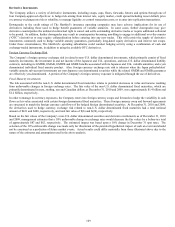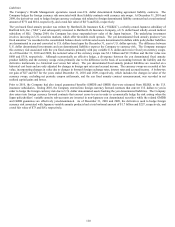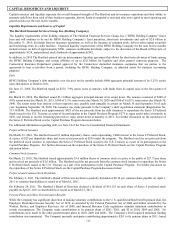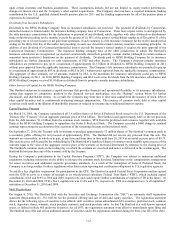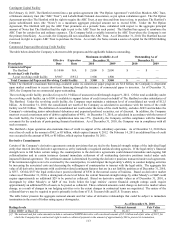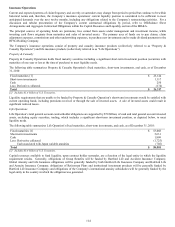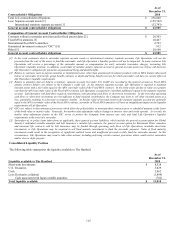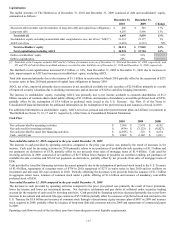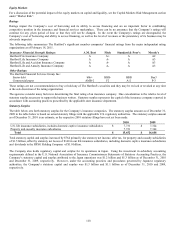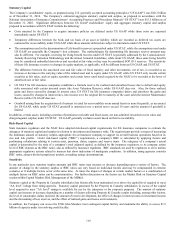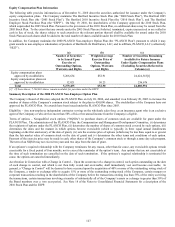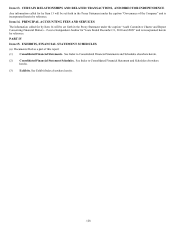The Hartford 2010 Annual Report Download - page 119
Download and view the complete annual report
Please find page 119 of the 2010 The Hartford annual report below. You can navigate through the pages in the report by either clicking on the pages listed below, or by using the keyword search tool below to find specific information within the annual report. 119
Statutory Capital
The Company’ s stockholders’ equity, as prepared using U.S. generally accepted accounting principles (“US GAAP”) was $20.3 billion
as of December 31, 2010. The Company’ s estimated aggregate statutory capital and surplus, as prepared in accordance with the
National Association of Insurance Commissioners’ Accounting Practices and Procedures Manual (“US STAT”) was $15.5 billion as of
December 31, 2010. Significant differences between US GAAP stockholders’ equity and aggregate statutory capital and surplus
prepared in accordance with US STAT include the following:
• Costs incurred by the Company to acquire insurance policies are deferred under US GAAP while those costs are expensed
immediately under US STAT.
• Temporary differences between the book and tax basis of an asset or liability which are recorded as deferred tax assets are
evaluated for recoverability under US GAAP while those amounts deferred are subject to limitations under US STAT.
• The assumptions used in the determination of Life benefit reserves is prescribed under US STAT, while the assumptions used under
US GAAP are generally the Company’ s best estimates. The methodologies for determining life insurance reserve amounts may
also be different. For example, reserving for living benefit reserves under US STAT is generally addressed by the Commissioners’
Annuity Reserving Valuation Methodology and the related Actuarial Guidelines, while under US GAAP, those same living benefits
may be considered embedded derivatives and recorded at fair value or they may be considered SOP 03-1 reserves. The sensitivity
of these life insurance reserves to changes in equity markets, as applicable, will be different between US GAAP and US STAT.
• The difference between the amortized cost and fair value of fixed maturity and other investments, net of tax, is recorded as an
increase or decrease to the carrying value of the related asset and to equity under US GAAP, while US STAT only records certain
securities at fair value, such as equity securities and certain lower rated bonds required by the NAIC to be recorded at the lower of
amortized cost or fair value.
• US STAT for life insurance companies establishes a formula reserve for realized and unrealized losses due to default and equity
risks associated with certain invested assets (the Asset Valuation Reserve), while US GAAP does not. Also, for those realized
gains and losses caused by changes in interest rates, US STAT for life insurance companies defers and amortizes the gains and
losses, caused by changes in interest rates, into income over the original life to maturity of the asset sold (the Interest Maintenance
Reserve) while US GAAP does not.
• Goodwill arising from the acquisition of a business is tested for recoverability on an annual basis (or more frequently, as necessary)
for US GAAP, while under US STAT goodwill is amortized over a period not to exceed 10 years and the amount of goodwill is
limited.
In addition, certain assets, including a portion of premiums receivable and fixed assets, are non-admitted (recorded at zero value and
charged against surplus) under US STAT. US GAAP generally evaluates assets based on their recoverability.
Risk-Based Capital
State insurance regulators and the NAIC have adopted risk-based capital requirements for life insurance companies to evaluate the
adequacy of statutory capital and surplus in relation to investment and insurance risks. The requirements provide a means of measuring
the minimum amount of statutory surplus appropriate for an insurance company to support its overall business operations based on its
size and risk profile. Under risk-based capital (“RBC”) requirements, a company’ s RBC is calculated by applying factors and
performing calculations relating to various asset, premium, claim, expense and reserve items. The adequacy of a company’ s actual
capital is determined by the ratio of a company’ s total adjusted capital, as defined by the insurance regulators, to its company action
level of RBC (known as the RBC ratio), also as defined by insurance regulators. RBC standards are used by regulators to set in motion
appropriate regulatory actions related to insurers that show indications of inadequate conditions. In addition, rating agencies consider
RBC ratios, along with their proprietary models, in making ratings determinations.
Sensitivity
In any particular year, statutory surplus amounts and RBC ratios may increase or decrease depending upon a variety of factors. The
amount of change in the statutory surplus or RBC ratios can vary based on individual factors and may be compounded in extreme
scenarios or if multiple factors occur at the same time. At times the impact of changes in certain market factors or a combination of
multiple factors on RBC ratios can be counterintuitive. For further discussion on the factors see the Market Risk on Statutory Capital
section within Capital Markets Risk Management of the MD&A.
Statutory capital at the Property & Casualty subsidiaries has historically been maintained at or above the capital level required to meet
“AA level” ratings from rating agencies. Statutory capital generated by the Property & Casualty subsidiaries in excess of the capital
level required to meet "AA level" ratings is available for use by the enterprise or for corporate purposes. The amount of statutory
capital can increase or decrease depending on a number of factors affecting Property & Casualty results including, among other factors,
the level of catastrophe claims incurred, the amount of reserve development, the effect of changes in interest rates on investment income
and the discounting of loss reserves, and the effect of realized gains and losses on investments.
In addition, the Company can access the $500 Glen Meadow trust contingent capital facility and maintains the ability to access $1.9
billion of capacity under its revolving credit facility.


